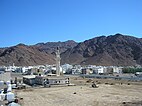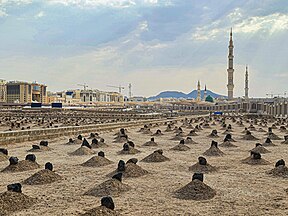
Medina
City in Medina Province, Saudi Arabia / From Wikipedia, the free encyclopedia
Dear Wikiwand AI, let's keep it short by simply answering these key questions:
Can you list the top facts and stats about Medina?
Summarize this article for a 10 year old
Medina,[lower-alpha 1] officially Al-Madinah al-Munawwarah (Arabic: المدينة المنورة, romanized: al-Madīnah al-Munawwarah, lit. 'The Luminous City', Hejazi Arabic pronunciation: [al.maˈdiːna al.mʊˈnawːara]) and also commonly simplified as Madīnah or Madinah (المدينة, al-Madina), is the capital of Medina Province in the Hejaz region of western Saudi Arabia. It is one of the oldest and most important places in Islamic history. One of the most sacred cities in Islam, the population as of 2022 is 1,411,599, making it the fourth-most populous city in the country. Around 58.5% of the population are Saudi citizens and 41.5% are foreigners.[3] Located at the core of the Medina Province in the western reaches of the country, the city is distributed over 589 km2 (227 sq mi), of which 293 km2 (113 sq mi) constitutes the city's urban area, while the rest is occupied by the Hejaz Mountains, empty valleys, agricultural spaces and older dormant volcanoes.
Medina
المدينة
| |
|---|---|
| Al-Madinah al-Munawwarah المدينة المنورة | |
| Coordinates: 24°28′12″N 39°36′36″E | |
| Country | |
| Province | Medina Province |
| First settled | 9th century BCE |
| Hijrah | 622 CE (1 AH) |
| Saudi conquest of Hejaz | 5 December 1925 |
| Named for | Muhammad |
| Districts |
|
| Government | |
| • Type | Municipality |
| • Body | Madinah Regional Municipality |
| • Mayor | Fahad Al-Belaihshi[1] |
| • Provincial Governor | Prince Salman bin Sultan Al Saud |
| Area | |
| • City | 589 km2 (227 sq mi) |
| • Metro | 22,900 km2 (8,800 sq mi) |
| Elevation | 620 m (2,030 ft) |
| Highest elevation | 1,077 m (3,533 ft) |
| Population (2022 census)[2] | |
| • City | 1,411,599 |
| • Rank | 4th |
| • Density | 2,012/km2 (5,212/sq mi) |
| • Metro | 1,477,047 (Medina Governorate) |
| Demonym(s) | Madani مدني |
| Time zone | UTC+03:00 (SAST) |
| Website | www |
 | |
Medina is generally considered to be the "cradle of Islamic culture and civilization".[4] The city is considered to be the second-holiest of three key cities in Islamic tradition, with Mecca and Jerusalem serving as the holiest and third-holiest cities respectively. Al-Masjid al-Nabawi (lit. 'The Prophet's Mosque') is of exceptional importance in Islam and serves as burial site of the prophet Muhammad, by whom the mosque was built in 622 CE (first year of the Hijrah). Observant Muslims usually visit his tomb, or rawdhah, at least once in their lifetime during a pilgrimage known as Ziyarat, although this is not obligatory.[5] The original name of the city before the advent of Islam was Yathrib (Arabic: يَثْرِب), and it is referred to by this name in Chapter 33 (Al-Aḥzāb, lit. 'The Confederates') of the Quran. It was renamed to Madīnat an-Nabī (lit. 'City of the Prophet' or 'The Prophet's City') after Muhammad's death and later to al-Madinah al-Munawwarah (lit. 'The Enlightened City') before being simplified and shortened to its modern name, Madinah (lit. 'The City'), from which the English-language spelling of "Medina" is derived. Saudi road signage uses Madinah and al-Madinah al-Munawwarah interchangeably.[5]
The city existed for over 1,500 years before Muhammad's migration from Mecca,[6] known as the Hijrah. Medina was the capital of a rapidly-increasing Muslim caliphate under Muhammad's leadership, serving as its base of operations and as the cradle of Islam, where Muhammad's ummah (lit. 'nation')—composed of Medinan citizens (Ansar) as well as those who immigrated with Muhammad (Muhajirun), who were collectively known as the Sahabah—gained huge influence. Medina is home to three prominent mosques, namely al-Masjid an-Nabawi, Quba Mosque, and Masjid al-Qiblatayn, with the Quba Mosque being the oldest in Islam. A larger portion of the Qur'an was revealed in Medina in contrast to the earlier Meccan surahs.[7][8]
Much like most of the Hejaz, Medina has seen numerous exchanges of power within its comparatively short existence. The region has been controlled by Jewish-Arabian tribes (up until the fifth century CE), the ʽAws and Khazraj (up until Muhammad's arrival), Muhammad and the Rashidun (622–660), the Umayyads (660–749), the Abbasids (749–1254), the Mamluks of Egypt (1254–1517), the Ottomans (1517–1805), the First Saudi State (1805–1811), Muhammad Ali of Egypt (1811–1840), the Ottomans for a second time (1840–1918), the Sharifate of Mecca under the Hashemites (1918–1925) and finally is in the hands of the present-day Kingdom of Saudi Arabia (1925–present).[5]
In addition to visiting for Ziyarah, tourists come to visit the other prominent mosques and landmarks in the city that hold religious significance such as Mount Uhud, Al-Baqi' cemetery and the Seven Mosques among others. The Saudi government has also carried out the destruction of several historical structures and archaeological sites, both in Medina and Mecca.[9]







